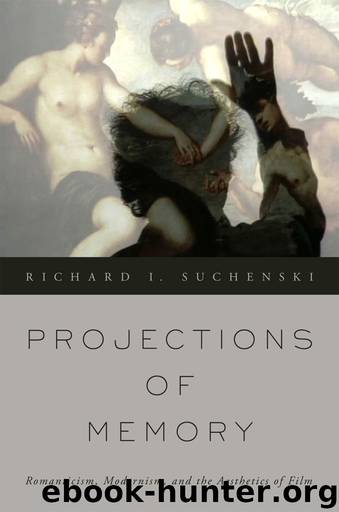Projections of Memory by Richard I. Suchenski

Author:Richard I. Suchenski [Suchenski, Richard I.]
Language: eng
Format: epub
ISBN: 9780190274108
Publisher: Oxford University Press
Published: 2016-06-29T22:00:00+00:00
FIGURE 4.18 Film being worked by hand in JLG/JLG—Self-Portrait in December (Jean-Luc Godard, 1994).
FIGURE 4.19 Detail of The Marriage of Bacchus and Ariadne (Jacopo Tintoretto, 1578, Palazzo Ducale, Venice) superimposed with Jean-Luc Godard in Scénario du film Passion (Jean-Luc Godard, 1982).
In treating hands as he does in Nouvelle vague, Godard invokes the most iconographically charged depiction of outstretched hands in the Western canon, the divine touch in Michelangelo’s The Creation of Adam (1508–1512). Godard never refers to the Sistine Chapel image directly, but the relationship between sacred love and physical contact informs much of the work made during the period of Histoire(s) du cinéma. In Scénario du film Passion (1982), for example, Godard assigns a privileged place to another sort of “divine” love, Tintoretto’s painting The Marriage of Bacchus and Ariadne (1578), which he describes as embodying both the subject of his film—one man and two women—and the idea of a sacred trinity (figure 4.19).185 Scénario du film Passion is the longest and most substantive of the video “sketches” that Godard completed in this period, and, like the others, it is replete with images of hands in motion—operating an editing table, gesticulating to the viewer, or raised, like those of a suppliant, before a movie screen. Like Stéphane Mallarmé’s blank page (to which it is compared), the screen remains “empty” throughout the video, but images of several of the canvases re-enacted as tableaux vivants in the accompanying feature (Passion) are superimposed with an image of Godard himself. As in Ingmar Bergman’s Persona (1966), the screen becomes a metaphor for the Cartesian separation of the body and the psyche, a surface on which psychological yearnings and needs can be projected. Yet by layering dim reproductions of canvases on top of pixelated video imagery, Godard subsumes everything onscreen within the visual imagination of the filmmaker in the center. In “matching” the central touch in the Tintoretto canvas with the outstretched arms of the director, Godard goes even further, turning those same hands into expressions of his demiurgic authority.
Godard ends Une histoire seule (1B) with a brief sequence that cinematically distills this dynamic. After an extended montage that focuses on the lost innocence of the cinema by linking post-1945 film icons like La terra trema (Luchino Visconti, 1948) with proto-cinematic materials from the late nineteenth century, Godard inserts an intertitle reading “au paradis perdu” and includes sound of Maria Casarès reading a passage from Martin Heidegger’s 1946 essay, “What Are Poets For?”
Poets are the mortals who, singing earnestly … sense the trace of the fugitive gods, stay on the gods’ tracks, and so trace for their kindred mortals the way toward the turning…. But who has the power to sense, to trace such a track? Traces are often inconspicuous, and are always the legacy of a directive that is barely divined. To be a poet in a destitute time means: to attend, singing, to the trace of the fugitive gods.186
When this text had been quoted earlier in Une histoire seule (1B), it was
Download
This site does not store any files on its server. We only index and link to content provided by other sites. Please contact the content providers to delete copyright contents if any and email us, we'll remove relevant links or contents immediately.
Kathy Andrews Collection by Kathy Andrews(11707)
Thirteen Reasons Why by Jay Asher(8766)
The Red Files by Lee Winter(3357)
How to Do Nothing by Jenny Odell(3218)
The Genius of Japanese Carpentry by Azby Brown(3209)
Stacked Decks by The Rotenberg Collection(2796)
Tattoo Art by Doralba Picerno(2582)
Champions of Illusion by Susana Martinez-Conde & Stephen Macknik(2403)
The Artist's Way Workbook by Cameron Julia(2185)
The Art of Doom by Bethesda(2098)
Calligraphy For Dummies by Jim Bennett(1978)
Creative Character Design by Bryan Tillman(1878)
Botanical Line Drawing by Peggy Dean(1799)
Wall and Piece by Banksy(1769)
The Art of Creative Watercolor by Danielle Donaldson(1764)
One Drawing A Day by Veronica Lawlor(1758)
Art Of Atari by Tim Lapetino(1670)
Pillars of Eternity Guidebook by Obsidian Entertainment(1611)
Happy Hand Lettering by Jen Wagner(1548)
